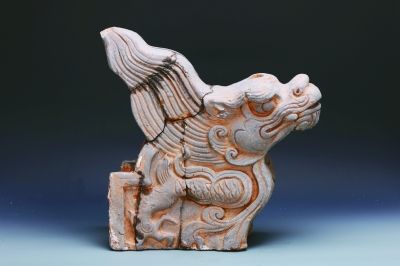Dig unlocks mysteries of Taoist temple site

An animal face tile unearthed at the Grand Shangqing Palace site (PHOTO: GUANGMING DAILY)
On Dec. 30, the Jiangxi Provincial Institute of Cultural Relics and Archeology announced that it had made remarkable progress in excavating the Grand Shangqing Palace after four years of diligent efforts. After analyzing historical records, experts said that the palace is the largest and most sophisticated temple site of the Zhengyi branch of Taoism to hold the characteristics of a royal palace. It held the richest relics and revealed the clearest stratigraphic relationship among Taoist temple sites, which marked a significant breakthrough in Chinese religious archaeology.
The Grand Shangqing Palace is located in the east of Longhu Mountain in Jiangxi Province. Constructed during the Northern Song Dynasty, the Palace was an ancestral temple for the Taoist gurus of the Zhengyi branch through the Song, Yuan, Ming and Qing dynasties.
However, an accidental fire in 1930 destroyed the Grand Palace, leaving only the Fudi Gate, Xiama Pavilion, Wuchao Gate, bell tower, Dongyin Court, and the three pavilions with tablets. In 2000, Yingtan City started reconstruction efforts on the Grand Palace. In June 2014, during the second phase of the project, large-scale architectural relics were discovered. In particular, a tablet recording the Emperor Jiaqing’s reconstruction of the Palace in the 15th year of his rule was unearthed. Since then, the relics of the palace has slowly emerged from the dust of history.
The site of the Grand Shangqing Palace is located on a gently sloping mountain, facing mountains on three sides and descending southward. Its outermost periphery is surrounded by a wall. According to the preliminary estimates by archeologists, the site of the Shangqing Palace covers an area of more than 300,000 square meters (currently 180,000 square meters has been explored), equivalent to half of Beijing’s Forbidden City.
The relics and artifacts unearthed reflect the imperial style of the Grand Palace. In terms of architectural regulations, the main palaces were built along the symmetric axis from south to north, which resembled the architectural form of the Qianqing-Kunning palaces in the Forbidden City. The main buildings along the axis are: Longhu Gate, Jade Emperor Hall, the Earth Temple, and the Sanqing Cabinet. The east and west sides of the main halls are the corresponding side halls connected by corridors and wing-rooms.
In terms of building materials, the Grand Palace unearthed a large number of stone pillars, such as the 86 centimeter long, 64 centimeter diameter base of a pedestal in Sanqing Court, which is a rarity in Taoist temples because only royal buildings use such huge stones. In addition, the unearthed cultural relics are rich in ornamentation, in particular, the majority of building materials were decorated with more than 11 kinds of Loong patterns. The use of Loong decorations distinguishes the Grand Palace from other Taoist temples.
The unearthed artifacts found at the site have mainly been building materials and domestic utensils. Building materials are mainly divided into three categories: colored glaze, gray pottery and stone building components. The glaze components are mostly ridge decorations, such as eave tiles, triangle-shaped edges on one end of a type of tile, semicircle-shaped tiles and pan tiles. The gray pottery components are more varied. In addition to the large number of tiles, many carved spine bricks have been found. The stone components mainly consist of railings and column bases.
In terms of the age of the components, a lot of single-leaf lotus eaves tiles and animal face tiles are relics from the Song and Yuan dynasties; the decorations of a large number of green glazed tiles and ridges demonstrate they are from the Ming Dynasty; the yellow glaze components are relics of the Qing Dynasty.
The domestic cooking utensils can be divided into Song, Yuan, Ming and Qing porcelain. More unearthed porcelain items were from the Song Dynasty, mostly blue and white porcelain. The unearthed Yuan Dynasty porcelain mainly consisted of bowls, plates and cups. The unearthed Ming Dynasty porcelain mainly included blue and white porcelain in folk kilns, imitation Longquan bowls, and other plates. The unearthed Qing Dynasty porcelain mostly consisted of blue and white bowls and cups.
Xu Changqing, dean of Jiangxi Provincial Institute of Cultural Relics and Archeology, said the rich relics of the Grand Shangqing Palace show that it is a religious building that combines architectural styles of northern and southern China with both civil and official architectural regulations. For example, cobblestones are used on large areas on the grounds of the Palace, which is extremely rare in the official buildings in the North. In contrast, the thickness of the main building wall reaches 60 to 90 centimeter, a typical Northern style that is rarely seen in the South.
